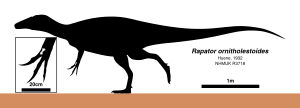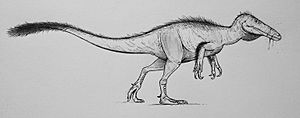Rapator facts for kids
Quick facts for kids Rapator |
|
|---|---|
 |
|
| Illustration of holotype manual bone | |
| Scientific classification |
|
| Kingdom: | Animalia |
| Phylum: | Chordata |
| Clade: | Dinosauria |
| Clade: | Saurischia |
| Clade: | Theropoda |
| Clade: | †Megaraptora |
| Genus: | †Rapator von Huene, 1932 |
| Type species | |
| †Rapator ornitholestoides von Huene, 1932
|
|
| Synonyms | |
|
|
Rapator was a type of theropod dinosaur that lived in Australia a very long time ago. It roamed the land during the Cretaceous period, about 105 to 96 million years ago. Its only known species is called Rapator ornitholestoides, and it was first named by a scientist named Friedrich von Huene in 1932.
Discovering Rapator
The only known fossil of Rapator is a single left hand bone. This special bone, called the holotype, was found around 1905. It was discovered near Wollaston, in an area known as Lightning Ridge. What's really cool is that this fossil has turned into opal, making it very beautiful!
The name "Rapator" is a bit of a puzzle. The scientist who named it, von Huene, didn't explain why he chose it. The word "Rapator" isn't a common Latin word. It might have come from a Latin word meaning "to plunder" or "to seize." Some people think it might even be a mistake for the word "raptor," which means "seizer" or "thief."
The second part of its name, ornitholestoides, means "resembling Ornitholestes." This is because the bone looked similar to a bone from another dinosaur called Ornitholestes.
Recently, more dinosaur bones were found in opal fields near Lightning Ridge. People called this new discovery "Lightning Claw." These new bones might actually belong to Rapator, which would be very exciting!
What Rapator Was Like
The only bone found, a hand bone, is about seven centimeters long. This bone has a special bump on it, which is also seen on the much smaller dinosaur Ornitholestes. Even though the bump is less clear on Ornitholestes, it was enough for scientists to name Rapator after it.
Scientists believe that if Rapator was built like another dinosaur called Australovenator, it would have been quite large. Some experts estimate it could have been as long as nine meters (about 30 feet)! That's as long as a school bus!
How Scientists Classify Rapator
When the Rapator bone was first found, scientists thought it was a metacarpal, which is a bone from the upper part of a dinosaur's hand. But later, they noticed it looked more like a finger bone, specifically the first bone of the first finger. This type of bone is found in dinosaurs like alvarezsaurs or early coelurosaurs, similar to Nqwebasaurus.
With the discovery of Australovenator, which had a similar hand bone, scientists realized that Rapator was likely a megaraptoran. Megaraptorans were a group of large, meat-eating dinosaurs. In fact, the bones of Australovenator and Rapator are so similar that some scientists wondered if they were actually the same dinosaur!
However, other scientists have found small differences between the bones. Also, Rapator and Australovenator lived about 10 million years apart. This makes it unlikely that they are the same dinosaur. So, for now, Rapator is considered its own unique dinosaur.
Rapator has also been linked to another dinosaur called Walgettosuchus, which was found in the same rock formation. But Walgettosuchus is only known from a single tail bone, so it's impossible to prove if they are the same animal.
See also
 In Spanish: Rapator ornitholestoides para niños
In Spanish: Rapator ornitholestoides para niños



